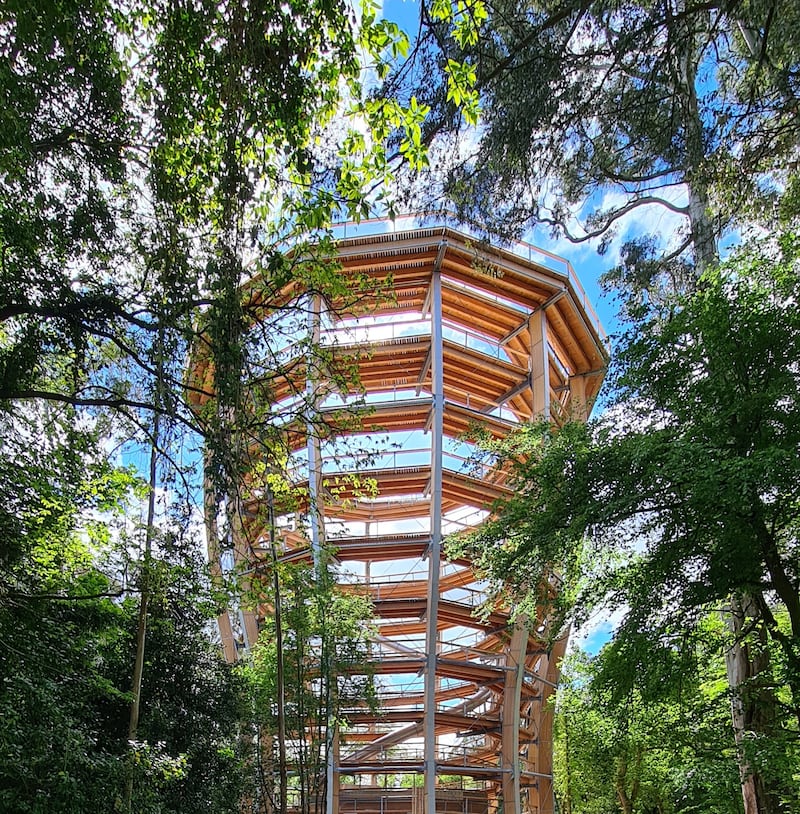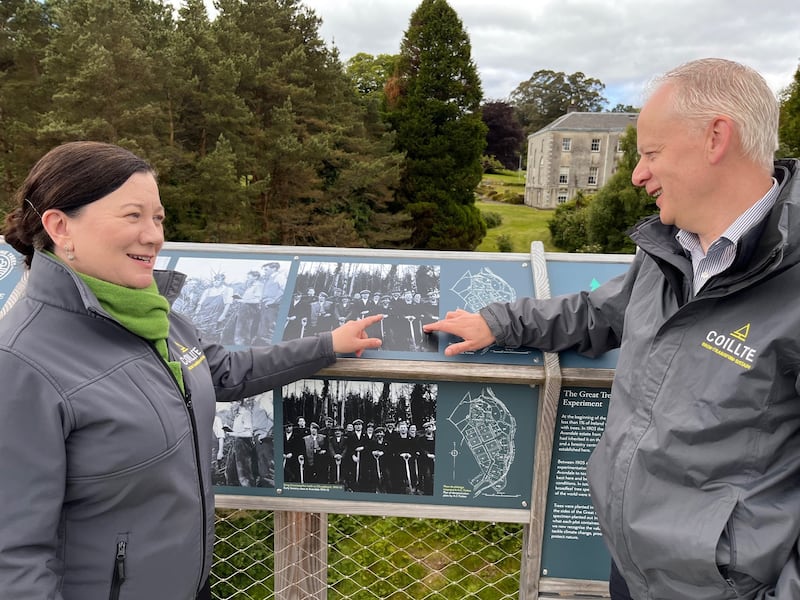Imelda Hurley grew up on a family farm in Clonakilty, Co Cork, a background that brought with it a deep understanding of land and food production, but her sustainability education was completed far from home.
Three years in China working as head of sustainability and chief financial officer for Liam Casey’s PCH International, one of Apple’s top technology assemblers, made her acutely aware of product impact. “That is where I started the sustainability journey and it has been pivotal to where I have arrived today,” she says.
As chief executive of State forestry company Coillte since 2019, wood has replaced devices in a role that embraces all its forms and uses, while being mindful of environmental and climate impacts.
Hurley divides her time between work at head office in Newtownmountkennedy, Co Wicklow, and locations around “the Coillte estate”, which makes up 7 per cent of Irish land. We meet at Avondale Forest Park with its spectacular treetop walk and viewing tower built in a joint venture with Fáilte Ireland and in partnership with EAK Ireland. It has attracted 680,000 visitors in under two years.
Besides having a significant historical house – the homestead of statesman Charles Stewart Parnell – Avondale is considered the home of Irish forestry. From 1770 it was owned by Samuel Hayes who, dismayed by the disappearance of Ireland’s ancient forests, planted numerous species from around the world. “What we have today is a wonderful arboretum that has been planted over centuries,” Hurley says.
Avondale came into State ownership in the early 1900s. “The great tree experiment”, identifying what trees grow best in Ireland, took place there. Answering that question today remains a subject of contention – the merits of native trees versus imported, fast-growing species (notably Sitka spruce, Douglas fir and Scots pine) and hardwoods versus softwoods.
“Visitors have a very wonderful experience,” Hurley says, but Coillte is most proud of the wood in the buildings, including great big Sitka spruce glulam beams, substituting carbon-intensive concrete and steel, and Douglas fir and larch in the walkway and viewing tower. It adds up to “a great showcase of what Irish forestry and Irish wood can deliver”.

Beyond the Trees Avondale is “one of a series of outstanding visitor offerings” Coillte is embarking on under its “forests for people” mandate, with €100 million investment planned by 2030. Portumna Forest Park in Co Galway and Lough Key Forest Park in Co Roscommon will follow with offerings appropriate to their location.
“We are very clear that our purpose is to manage the State’s forests on behalf of the people of Ireland, having mapped everything that Irish forests can deliver to the UN sustainable development goals. It links to nine goals, everything from sustainable construction to water and soil protection, health and wellbeing, energy.”
This has been distilled down to four critical objectives – “forests for climate, forests for nature, forests for wood and forests for people”. The State agency started work on this in 2020 when there was increased recognition of climate change and the need for climate solutions and biodiversity protection.
There was also big emphasis on health and wellbeing, rural economy jobs and sustainable homes.
“We brought all of that together and said that is the backdrop for our organisation. If we’re to talk about the multiple benefits, we must be very clear in our ambition. So we then set about identifying these ambitions against climate, nature, wood and people. And it’s very much all about balance.”
Hurley acknowledges divergent views on forestry: on the different tree species that should be planted, on silviculture models in managing forests and “whether trees should be cut at all”.
The imperative for Coillte is timber production in delivering sustainable homes, she says. Timber is “a very low-carbon building material. Modern methods of construction mean that timber [is a] very efficient way of delivering homes into the future”.
Modern methods of construction mean that timber [is a] very efficient way of delivering homes into the future
— Imelda Hurley
This is at a time of increasing challenges facing “wet trades” in traditional building, though the forestry sector, which employs 15,000 people, faces its own acute labour shortages.
Global demand for timber is predicted to quadruple between now and 2050. In that scenario, she says “it’s about being as self sufficient as possible in terms of wood that we need ... This is a fundamental part of delivering the multiple benefits of ‘forests that deliver for wood’.”
Timber price is the big uncertainty, Hurley accepts. It’s a worldwide commodity influenced by construction costs and interest rates, which makes for volatility. Last year Coillte’s modified earnings – earnings before interest tax depreciation and amortisation (Ebitda) – were €106 million, down from €157 million the previous year. Yet it was the fourth best year in terms of financial performance in its 35-year history.
The wood sector in Ireland is well placed, having invested in sawmills ensuring world-class timber production, she says. Coillte forests are sustainably certified for the past 20 years. Its two board mills through Medite Smartply produce engineered composite products for timber construction – medium density fibreboard (MDF) and oriented strand board (OSB) – in Clonmel and Waterford, generating €293 million in revenue last year.
Hurley is upfront on the Sitka issue: “It’s a very productive tree. It also sequesters carbon significantly faster than hardwoods. So it really delivers for sustainable homes and for climate. That isn’t as well-known as we need it to be.
“If the objective is to be self-sufficient in terms of Irish wood that can be used for construction, then softwood like Sitka spruce is absolutely a critical tree that we should be planting.”
Coillte plans to deliver 100,000 hectares of new forestry by 2050, half of which will be native woodlands. “We project that, in total, that 100,000 hectares would sink 18 million tonnes of carbon dioxide by 2050,” she says. Ireland emitted 61 million tonnes in 2022.
Low afforestation levels are the progress blocker. The national target is to increase forest cover from 11.6 per cent of the State to 18 per cent before 2050. That involves 450,000 hectares of additional forestry and planting 8,000 hectares a year. What is being achieved is 20-25 per cent at best, she says.
[ Restoring bogs is more complex than just removing treesOpens in new window ]
A new €1.3 billion national forestry programme, launched last September, is reaching ramp-up phase with grants and premiums at their highest level to date, Hurley says. For Coillte, the challenge is availability of suitable sites. “As Ireland’s largest landowner, we don’t have land available to plant ourselves because the estate is fully deployed.”
While they want to acquire land, she says the biggest driver of afforestation ultimately will be private landowners and farmers, who will determine the species mix.
Hurley declines to revisit the prolonged controversy over licensing for planting and felling but acknowledges that 2020 and 2021 “was a very difficult and challenging time for everyone in the sector”.
A revamped processing system is now better resourced by the Department of Agriculture. With new regulations coming from Europe, she highlights a contrast in the capacity to deal with this between a large organisation like Coillte and “many individual farmers [who] might have one forest stand that they’re managing through a lifetime”.

What is important for all, she says, is that regulations are streamlined as much as possible, especially in drawing up standard and special conditions on licences.
About 15,000-18,000 hectares of land come on the market each year, with many competing demands: infrastructure; agriculture – the nitrates directive means farmers are seeking to increase landholdings – and then forestry. Coillte is looking at availability of public lands by engaging with local authorities on what they might have and working directly with Bord na Móna on its cutaway bogs.
Some prices make forestry impossible. A land use strategy for Ireland is critically important, Hurley says, with “understanding of the importance of forestry in terms of being self-sufficient as possible in the long term for timber production”.
“There were some trees planted for very good reason in the past to create rural employment that, based on the science and what we know today, one wouldn’t do,” she says.
Coillte aims to redesign 30,000 hectares of peatland forests for climate and ecological benefits by 2030. The first initiative is focused on areas of Atlantic blanket bog in the west drained in the 1950s and 1960s and planted with conifers. This is starting in Derryclare, Connemara, a 350-hectare area where a range of proposed restorative measures include removing conifers and planting native trees where appropriate.
With the EU’s nature restoration law set to drive rehabilitation and protection of habitats and ecosystems, Coillte’s contribution will come from its forest estate strategic land use plan, a 10-year window informed by modelling scenarios.
[ What impact will the EU nature restoration law have on Ireland?Opens in new window ]
It is working under Dogpatch Labs’ sustainability innovation accelerator programme with CarbonStack, which uses satellite images to identify damaged forest areas and calculates carbon uptake in several climate scenarios to select the best species for each location. Coillte is planning to increase the carbon store by 10 million tonnes between now and 2050.
Some 20 per cent (90,000 hectares, equivalent to total area of Ireland’s national parks) of its estate has been managed with nature and biodiversity as its primary purpose over the past 20 years. That will increase to 30 per cent by the end of 2025.
Continuous cover forestry to create a broader age distribution over time is being deployed but this depends on soil type and elevation. The “thin, clear fell and replant model” elsewhere is critical to delivering 25 million cubic metres of sustainably certified Irish timber annually “to support the construction of 300,000 homes by 2030″, Hurley says.
“For every tree we fell, we plant three trees in its place. So last year we planted 18 million trees across the estate,” she says.
“Build with wood” is not always considered in Ireland. Between a fifth and a quarter of houses being built annually are timber frame. In Scotland, with a similar climate to Ireland, the figure is 80 per cent “so there’s no reason why we can’t do considerably more”, she says.
Coillte also plans to deliver one gigawatt of wind energy (enough to power 500,000 homes) on its estate in conjunction with the ESB under Future Energy Ireland. Their first wind farm in Lenalea, Co Donegal, is up and running. Thirty-six wind turbines were built on the estate last year across four wind farms, generating enough to power 80,000 homes.
“We have had some part in the delivery of 50 per cent of all the installed wind energy in the country,” Hurley says.
Ambitions for 2050 are completed by a target of doubling forestry recreation areas to 500 and creating 1,200 jobs in rural communities to support a just transition to a low-carbon economy.
Coillte has an essential role in communicating how forestry’s multiple benefits can be realised, Hurley says, while highlighting “the green tech jobs [and] the wonderful opportunity to work in the outdoors with nature in a sector that really does deliver sustainability”.
[ When the extreme heat hits Ireland, we’ll be grateful to the treesOpens in new window ]
“Carbon is a new language on how we conduct our business,” she says.
All that has to be backed by being commercially successful. “Sustainable means financial sustainability as well,” Hurley says.
She has learned the importance of making progress every year even though forestry is long-term. “The forests that we see today here [in Avondale] were there before our time, and hopefully will be there after our time, so the actions taken today have really long-term consequences.”
She recasts an old phrase on forestry: it is a wise person who plants a tree that they may never live to enjoy.
CV
Name: Imelda Hurley
Job: chief executive, Coillte
Age: 52
Lives: Terenure, Dublin
Hobbies: Adventure travel, hiking and spending time in the outdoors.
Something we might expect: Enjoys being out in nature and hiking. She has climbed two of the seven summits (the tallest peaks on the seven continents) with at least one more on her bucket list.
Something that might surprise: A former executive with technology company PCH International. While undertaking this role, she lived in Hong Kong for three years, working primarily in Shenzhen in south China.
- Sign up for push alerts and have the best news, analysis and comment delivered directly to your phone
- Join The Irish Times on WhatsApp and stay up to date
- Listen to our Inside Politics podcast for the best political chat and analysis


















